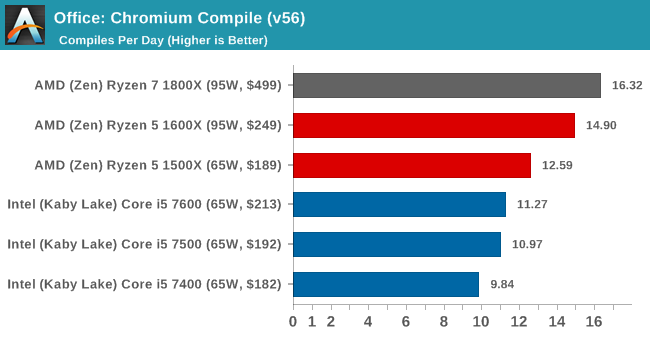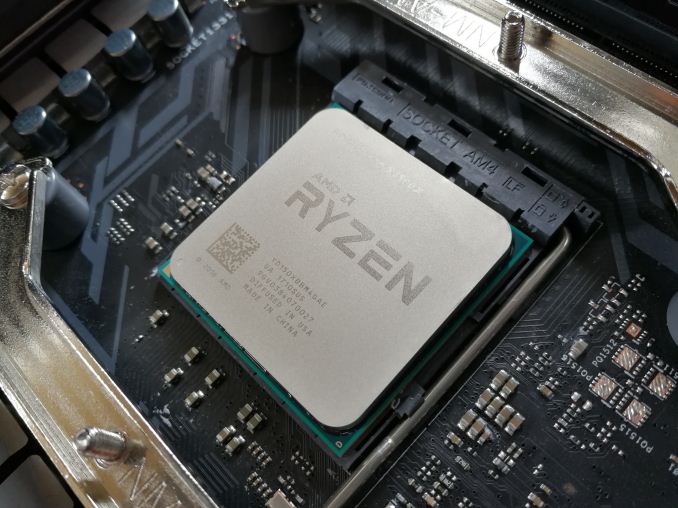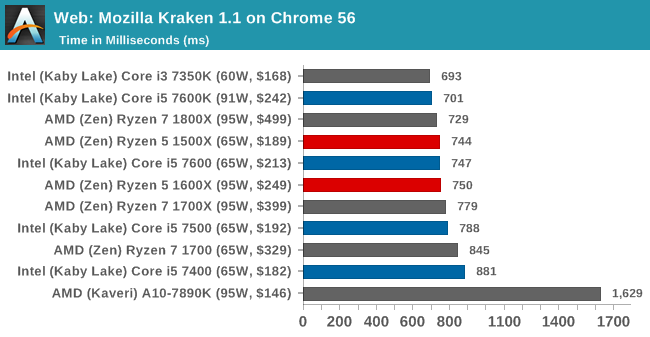The AMD Ryzen 5 1600X vs Core i5 Review: Twelve Threads vs Four at $250
by Ian Cutress on April 11, 2017 9:00 AM ESTAMD Ryzen 5
We mentioned at the top of the review that AMD’s Ryzen 7 launch last month benefited in a market where the competition was extremely expensive – being able to offer equivalent performance in most tasks and then undercut the competition by 50% is a difficult task, but the opening was always there due to a lack of competition in this space. When it comes to the mainstream market, the Ryzen 5 processors are actually competing on price with Intel’s processors directly, and thus has to offer something more to compete.
We have already shown in previous reviews that the Zen microarchitecture from AMD is around the equivalent of Intel’s Broadwell microarchitecture, but at this lower price point we have AMD’s Zen against Intel’s Kaby Lake, which is two generations newer than Broadwell and affords a comfortable IPC uplift over Broadwell. Given AMD’s monolithic design strategy of a single silicon die catering for most of their product line (well, all of it so far), the way AMD is tackling this is through more cores.
Before the debate about cores from AMD’s past rears its head (Vishera/Bulldozer designs in that case), given that AMD’s single thread performance is not too far behind, having a big set of cores as an alternative is something interesting for end-users, especially as more work flows and gaming titles rely on multithreading to scale. As a result, where Intel offer four cores and four threads, AMD is now offering six cores and twelve threads – a potential +200% uptick in the number of threads and +50% in cores, albeit at 10-15% lower instructions per clock.
(There’s also a side argument here about die sizes and wafer costs to each company to consider, but we will leave that for a different piece.)
For this review, based on time and available parts, we tested the Ryzen 5 1600X six-core processor against a set of Intel Core i5 parts that users might also be considering. We have some Ryzen 5 1500X quad-core numbers in here as well, and that might be spun out into a separate review at a later date. We also demonstrated our new 2017 CPU gaming tests, with four GPUs, six tests, two resolutions per test, and a couple of extra extreme resolution tests.
On The Benchmark Results
Looking at the results, it’s hard to notice the effect that 12 threads has on multithreaded CPU tests. The usual culprits show big wins for AMD here: 2D to 3D photo conversion, ray tracing, Blender, Cinebench, Encryption and video transcoding are all sizable wins. This is the sort of workload in which moving up to the Ryzen 7 CPUs, budget permitting, also do well on.
A new test in our suite for this review is a Compile Chromium test on Windows. As part of our testing suite, we have a fixed nightly download from mid-March and set this to compile, taking the final time and converting it into how many compiles per day. For around $250, Ryzen is the only way to go:

As you would expect, AMD still lags in IPC to Intel, so a 4.0 GHz AMD chip can somewhat compete in single threaded tests when the Intel CPU is around 3.5-3.6 GHz, and the single thread web tests/Cinebench results show that.
On The Gaming
Our gaming tests are a mix of Full-HD and 4K testing, some of which ends up being more CPU limited than we expected.
Civilization, at both 1080p and 4K Ultra settings, seem to scale quite happily with more cores on all GPUs, except the GTX 1060 at 4K. It’s worth noting situations such as the R9 Fury at 1080p Ultra only has 920ms under 60 FPS on the 1600X, compared to 6300 milliseconds on the Core i5-7600.
Shadow of Mordor leans towards the higher IPC of Intel, as the DX11 title cannot take advantage of the cores as much. Rise of the Tomb Raider’s benchmark is notorious for having each of its three seconds perform differently with respect to CPU scaling, with the Prophets scene being more CPU limited than the rest of the stage in the game.
Rocket League using an AMD CPU + AMD GPU actually provides more equal results with NVIDIA GPUs, however there's a performance drop using Ryzen + NVIDIA, which potentially correlates towards a driver bug but we're not 100% sure what is going on. Grand Theft Auto is a mixed bag, despite being a DX11 title – in some situations the Ryzen 5 is ahead of the Intel CPUs, or they all perform about the same, or the Intel CPUs pull ahead.
I have $250, What Should I Get – the Core i5 7600/7600K or the Ryzen 5 1600X?
Platform wise, the Intel side can offer more features on Z270 over AM4, however AMD would point to the lower platform cost of B350 that could be invested elsewhere in a system.
On performance, for anyone wanting to do intense CPU work, the Ryzen gets a nod here. Twelve threads are hard to miss at this price point. For more punchy work, you need a high frequency i5 to take advantage of the IPC differences that Intel has.
For gaming, our DX12 titles show a plus for AMD in any CPU limited scenario, such as Civilization or Rise of the Tomb Raider in certain scenes. For e-Sports, and most games based on DX9 or DX11, the Intel CPU is still a win here.












254 Comments
View All Comments
vladx - Thursday, April 13, 2017 - link
Yes as someone with both a 7700k system and a 1700X system I can safely call myself unbiased as I hold no special loyalty towards any brand.Cooe - Monday, March 1, 2021 - link
Liar liar, pants on fire lol.cryosx - Thursday, April 13, 2017 - link
they were testing against the direct competition (i5s) and the rest of the ryzen family. Makes sense, though I guess having the i7s in would be a nice touch.Nightsd01 - Wednesday, April 12, 2017 - link
"[Ryzen] has 50% more cores and 200% more threads"Wouldn't it be 300% more threads? 12 threads is 3x more than 4
Outlander_04 - Thursday, April 13, 2017 - link
200% MOREcvearl - Thursday, April 13, 2017 - link
Curious what method on GTAV was used. I get in the 70's at those settings on my RX480 all VH settings on an i7 2600k.ianmills - Thursday, April 13, 2017 - link
Dolphin benchmarks still missing!Notmyusualid - Tuesday, April 18, 2017 - link
@ianmillsI was looking for them too.
msroadkill612 - Thursday, April 13, 2017 - link
Ryzens tough for cheapskates. its a nice cheap 4 core, but gee, for so little more u get a 6 core 1600.msroadkill612 - Thursday, April 13, 2017 - link
zen is just amds first act.The second is naples - gluing multiple ryzens together using their excellent new plumbing.
The third is vega (gpu has long been amdS focus - in a10apuS e.g.).
The last and seismic act, is a ccx with a single zen core block of four cores & same 4mb l3 cache, and a vega gpu, possibly with hbm2 vram.
Its not very new ground for them. its very similar to the architecture solutions needed for the a10.
Incidentally, i heard a great debate about "dark coding?".
coders love using the gpu for compute when they can, cos it shifts heat away from stressed processors. cooler processors can then run faster. IE, they try and shift the load around the circuitry to avoid generating hot spots.
The conclusion omitted to say "if u consider pc software static.... Then buy intel"
new generation and paradigm, or the last tart up of the old generation. Your choice.
There are of course wins and losses by both, but we know that we are measuring the best of the old, with the lowest point of the rapidly improving new. (see ashes of singularitytweak)
& as above, its just act 1 now.
The authors haughty dismissal of amdS top am4 chipset features is outrageously deceptive (as said in posts here).